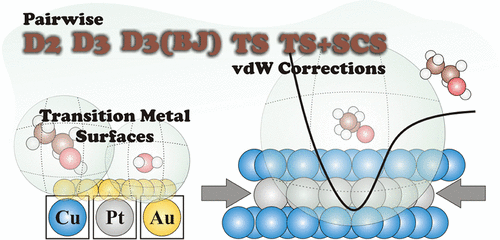当前位置:
X-MOL 学术
›
J. Phys. Chem. C
›
论文详情
Our official English website, www.x-mol.net, welcomes your
feedback! (Note: you will need to create a separate account there.)
Comparison of the Performance of van der Waals Dispersion Functionals in the Description of Water and Ethanol on Transition Metal Surfaces
The Journal of Physical Chemistry C ( IF 3.3 ) Pub Date : 2018-01-17 00:00:00 , DOI: 10.1021/acs.jpcc.7b09749 Rafael L. H. Freire 1 , Diego Guedes-Sobrinho 2 , Adam Kiejna 3 , Juarez L. F. Da Silva 4
The Journal of Physical Chemistry C ( IF 3.3 ) Pub Date : 2018-01-17 00:00:00 , DOI: 10.1021/acs.jpcc.7b09749 Rafael L. H. Freire 1 , Diego Guedes-Sobrinho 2 , Adam Kiejna 3 , Juarez L. F. Da Silva 4
Affiliation

|
Pairwise van der Waals (vdW) corrections have been routinely added to density functional theory (DFT) adsorption studies of inorganic or organic molecules on solid surfaces, however, comparative studies of the available pairwise corrections, e.g., D2, D3, D3(BJ), TS, and TS+SCS, are quite scarce. We report DFT calculations within the Perdew–Burke–Ernzerhof (PBE) functional to assess the performance of the mentioned pairwise vdW corrections for well-defined transition-metal (TM) systems, namely, the Cu, Pt, and Au bulks in the face-centered cubic structure, close-packed TM substrates (Cu(111), Pt(111), Au(111), Cu9/Pt9/Cu(111), Pt9/Cu9/Cu(111), Au9/Pt9/Au(111), Pt9/Au9/Au(111)), and the adsorption of water and ethanol on the selected substrates, which include strained Pt-monolayers, i.e., a good challenge for pairwise vdW corrections. In general, accounting for vdW interactions leads to smaller lattice constants, which is expected due to the attractive nature of the vdW corrections, and the D3, D3(BJ), and TS+SCS improves the DFT-PBE results, in contrast with D2 and TS. Compared with PBE results, the vdW corrections enhance the contraction of the topmost surface layers, which contributes to change the electronic structure, in particular, the d-band center shifts away from the Fermi energy (up to 0.3 eV) in most cases, while the work function changes by about 0.2 eV in the worst cases. As expected, the attractive nature of the vdW corrections helps to enhance adsorption energies by 3–4 times compared with DFT-PBE. However, the adsorption energy trends versus the d-band center are preserved for all vdW corrections, except for the DFT-D2 framework, which deviates substantially from the studied vdW corrections. Therefore, based on our results and analyses, we can conclude that the D3, D3(BJ), and TS+SCS corrections yield the best description for the selected systems.
中文翻译:

过渡金属表面上水和乙醇的描述中范德华分散功能的性能比较
成对范德华(vdW)校正已常规添加到固体表面上的无机或有机分子的密度泛函理论(DFT)吸附研究中,但是,对可用的成对校正的比较研究,例如D2,D3,D3(BJ) ,TS和TS + SCS相当稀缺。我们报告了Perdew-Burke-Ernzerhof(PBE)功能内的DFT计算,以评估针对明确过渡金属(TM)系统(即,脸上的Cu,Pt和Au块)的上述成对vdW校正的性能中心立方结构,紧密堆积的TM基板(Cu(111),Pt(111),Au(111),Cu 9 / Pt 9 / Cu(111),Pt 9 / Cu 9 / Cu(111),Au 9 /铂9 /金(111),铂9/ Au 9/ Au(111)),以及水和乙醇在选定衬底上的吸附,其中包括应变的Pt单层,即成对vdW校正的一个很好的挑战。通常,考虑vdW相互作用会导致较小的晶格常数,这是由于vdW校正具有吸引力的特性所预期的,与D2相比,D3,D3(BJ)和TS + SCS改善了DFT-PBE结果和TS。与PBE结果相比,vdW校正增强了最顶层表面层的收缩,这有助于改变电子结构,特别是在大多数情况下,d波段中心偏离了费米能量(最高达0.3 eV),而在最坏的情况下,功函数变化约0.2 eV。不出所料 与DFT-PBE相比,vdW校正的吸引人的性质有助于将吸附能提高3-4倍。但是,对于所有vdW校正,保留了相对于d波段中心的吸附能量趋势,但DFT-D2框架除外,该框架与所研究的vdW校正有很大不同。因此,根据我们的结果和分析,我们可以得出结论,D3,D3(BJ)和TS + SCS校正可为所选系统提供最佳描述。
更新日期:2018-01-17
中文翻译:

过渡金属表面上水和乙醇的描述中范德华分散功能的性能比较
成对范德华(vdW)校正已常规添加到固体表面上的无机或有机分子的密度泛函理论(DFT)吸附研究中,但是,对可用的成对校正的比较研究,例如D2,D3,D3(BJ) ,TS和TS + SCS相当稀缺。我们报告了Perdew-Burke-Ernzerhof(PBE)功能内的DFT计算,以评估针对明确过渡金属(TM)系统(即,脸上的Cu,Pt和Au块)的上述成对vdW校正的性能中心立方结构,紧密堆积的TM基板(Cu(111),Pt(111),Au(111),Cu 9 / Pt 9 / Cu(111),Pt 9 / Cu 9 / Cu(111),Au 9 /铂9 /金(111),铂9/ Au 9/ Au(111)),以及水和乙醇在选定衬底上的吸附,其中包括应变的Pt单层,即成对vdW校正的一个很好的挑战。通常,考虑vdW相互作用会导致较小的晶格常数,这是由于vdW校正具有吸引力的特性所预期的,与D2相比,D3,D3(BJ)和TS + SCS改善了DFT-PBE结果和TS。与PBE结果相比,vdW校正增强了最顶层表面层的收缩,这有助于改变电子结构,特别是在大多数情况下,d波段中心偏离了费米能量(最高达0.3 eV),而在最坏的情况下,功函数变化约0.2 eV。不出所料 与DFT-PBE相比,vdW校正的吸引人的性质有助于将吸附能提高3-4倍。但是,对于所有vdW校正,保留了相对于d波段中心的吸附能量趋势,但DFT-D2框架除外,该框架与所研究的vdW校正有很大不同。因此,根据我们的结果和分析,我们可以得出结论,D3,D3(BJ)和TS + SCS校正可为所选系统提供最佳描述。









































 京公网安备 11010802027423号
京公网安备 11010802027423号